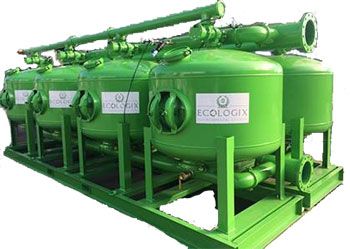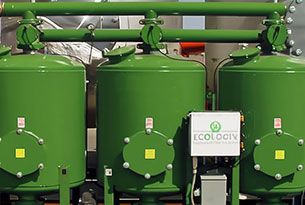Summary
Manganese is a naturally occurring element that can accumulate in lake water, causing aesthetic issues and potential health risks. Green sand filters, utilizing a natural mineral called glauconite coated with manganese dioxide, offer an eco-friendly, efficient method for manganese removal through catalytic oxidation and filtration.

Introduction to Manganese in Lake Water and the Role of Green Sand Filters
Manganese is a naturally occurring element that can accumulate in lake water due to geological runoff, industrial discharges, or algal blooms, leading to aesthetic issues like black staining, metallic tastes, and potential health risks when consumed or used for irrigation. Elevated manganese levels also harm aquatic ecosystems by disrupting oxygen levels and fish health. For lake restoration projects or facilities drawing water from lakes for industrial use, effective removal is crucial. Green sand filters, utilizing a natural mineral called glauconite coated with manganese dioxide, offer an eco-friendly, efficient method for manganese removal through catalytic oxidation and filtration.
At Ecologix Environmental Systems, we integrate green sand filtration into our comprehensive water treatment solutions, helping municipalities, resorts, and industries achieve cleaner lake water while meeting regulatory standards. This article delves into how green sand filters work, key design factors like retention time and flow rate volume, and their practical applications.
How Green Sand Filters Remove Manganese
Green sand, a zeolite mineral (glauconite) coated with manganese dioxide (MnO₂), acts as both a filter media and a catalyst. The process relies on oxidation to convert soluble manganese (Mn²⁺) into insoluble manganese dioxide (MnO₂) particles, which are then trapped by the media:
- Pre-Oxidation: An oxidant like potassium permanganate (KMnO4) or chlorine is dosed upstream to initiate oxidation. This step ensures manganese is in a filterable form.
- Filtration Through Green Sand: As water passes through the filter bed, the MnO2 coating catalyzes further oxidation, while the porous structure captures the precipitates. The media can handle both iron and manganese, making it versatile.
- Regeneration: Over time, the media becomes saturated and is regenerated with a potassium permanganate solution to restore its oxidative capacity, extending its lifespan to 5-10 years with proper maintenance.
This natural mineral-based approach minimizes chemical use compared to synthetic alternatives, promoting sustainability in lake water treatment.
Key Design Considerations: Retention Time and Flow Rate Volume
Effective green sand filtration requires careful design to balance efficiency, capacity, and operational costs. Two critical parameters are retention time (the duration water contacts the media) and flow rate volume (the rate of water processed per unit area).
Retention Time
Retention time, often measured as Empty Bed Contact Time (EBCT), is calculated as EBCT = (Bed Volume) / Flow Rate. For green sand filters treating manganese:
- Typical EBCT ranges from 2-5 minutes to allow sufficient contact for oxidation and adsorption.
- Shorter times (e.g., 2 minutes) suit low-manganese waters (<0.3 mg/L), while higher times (4-5 minutes) are needed for elevated levels (up to 1-5 mg/L) common in some lakes.
- Increasing retention time by slowing flow or deepening the bed (minimum 24-30 inches) enhances removal efficiency to over 95%, but may require larger vessels. For lake water with organics, aim for 3-4 minutes to prevent fouling.
Flow Rate Volume
Flow rate determines the filter's throughput and is expressed in gallons per minute per square foot (gpm/sq. ft.) of filter surface area:
- Service Flow Rate: 3-5 gpm/sq. ft. for continuous operation, up to 8-12 gpm/sq. ft. intermittently for peak demands. For lake water treatment, start at 3-4 gpm/sq. ft. to handle variable turbidity.
- Backwash Flow Rate: 10-12 gpm/sq. ft. to expand the bed by 40% and remove trapped solids, typically for 10 minutes every 24-48 hours or based on pressure drop.
- Volume Considerations: For a 10 ft2 filter treating 50,000 gallons/day from a lake source, a 4 gpm/sq. ft. rate yields about 2,880 gallons/hour capacity. Scale up bed depth and area for higher volumes, ensuring no more than 700-1,200 grains of manganese per sq. ft. before regeneration.
Pilot testing is essential for lake-specific designs, as surface water organics can reduce effective flow rates by 20-30%. Ecologix's engineering team uses these parameters to customize systems, preventing breakthrough and ensuring consistent performance.
Benefits of Green Sand Filtration for Manganese Removal
Green sand filters provide multiple advantages for lake water management:
- High Efficiency: Removes 95-99% of manganese, even at concentrations up to 10 mg/L, producing clear, odor-free water.
- Natural and Sustainable: Uses a renewable mineral media with low chemical regeneration needs, reducing environmental impact compared to ion exchange or reverse osmosis.
- Cost-Effective: Lower capital costs than advanced membranes; operational savings from high capacity (up to 20,000 bed volumes before regeneration).
- Versatility: Handles co-contaminants like iron and hydrogen sulfide, ideal for untreated lake sources.
- Minimal Waste: Backwash water is often recyclable, minimizing discharge volumes.
Studies show optimized systems maintain effluent manganese below 0.05 mg/L, well under WHO guidelines.
Applications in Lake Water Treatment
Green sand filters are widely used for:
- Lake Restoration: Municipal projects to treat stormwater runoff or aerated lake water, preventing black deposits on shores.
- Industrial Intake: Factories or resorts drawing from lakes for cooling or processing, integrating with DAF for pretreatment.
- Aquaculture and Irrigation: Ensuring low-manganese water for fish farms or golf course ponds to avoid crop staining.
- Potable Water Prep: As a polishing step in surface water plants.
Ecologix's Green Sand Filtration Solutions
Ecologix Environmental Systems offers turnkey green sand filter systems tailored for manganese removal:
- Custom Designs: Vertical or horizontal pressure vessels with automated controls for flow rate and regeneration, optimized for 3-5 minute EBCT.
- Integrated Pretreatment: Paired with coagulation or ultrafiltration to handle lake organics, extending media life.
- High-Purity Media: We source durable greensand like GreensandPlus, ensuring reliable performance.
- Support Services: Site assessments, pilot testing, and maintenance to fine-tune retention and flow for your volume needs.
Our systems have helped clients reduce manganese by 98% in challenging lake environments, supporting sustainable water use.
Challenges and Best Practices
Potential hurdles include media fouling from organics (mitigated by pH adjustment to 7.0-8.0) and breakthrough from high flows (monitored via online sensors). Best practices:
- Conduct jar tests to determine oxidant dosing.
- Maintain backwash schedules based on 5-10 psi pressure rise.
- For high-volume lakes, use multi-stage filters to distribute flow.
Conclusion: Clear Lakes with Ecologix's Green Sand Expertise
Green sand filters harness the power of natural minerals to effectively remove manganese from lake water, with retention time and flow rate as pivotal design elements for success. This approach not only restores water quality but also aligns with eco-conscious goals. Partner with Ecologix Environmental Systems to implement a customized green sand solution that fits your flow volumes and retention needs.
